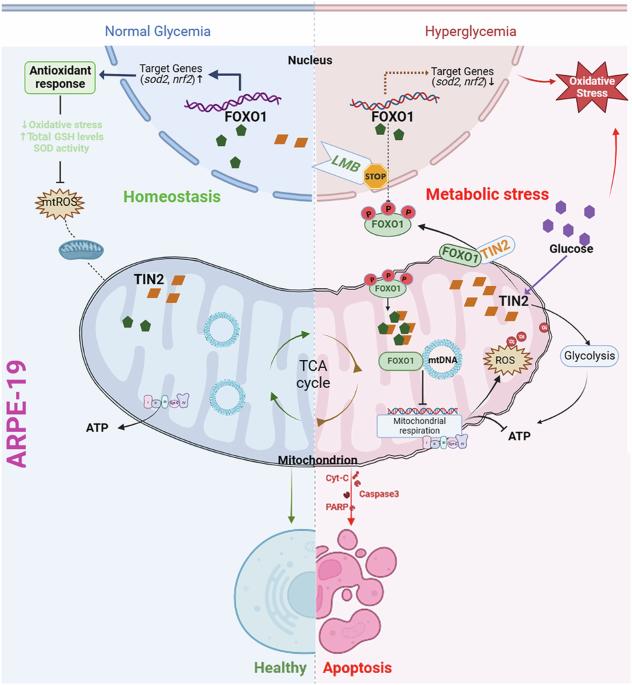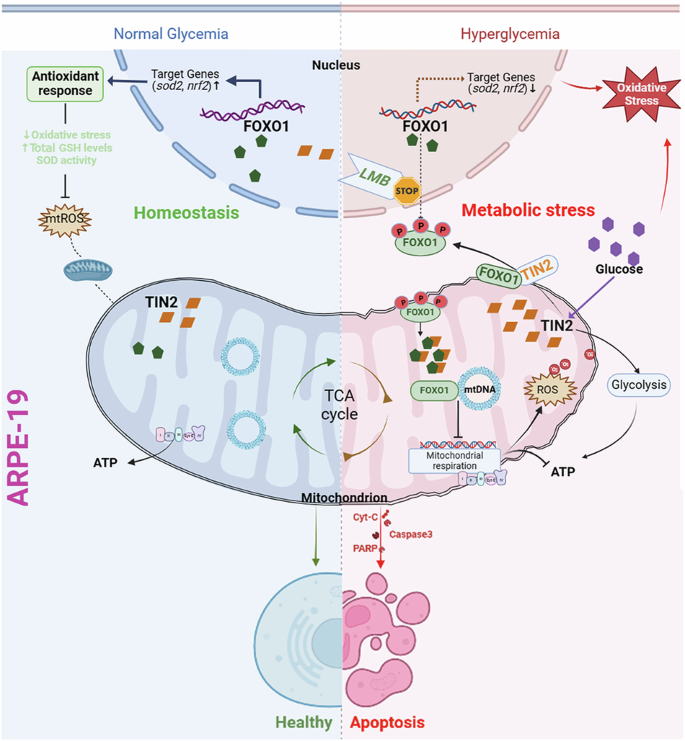TIN2 modulates FOXO1 mitochondrial shuttling to enhance oxidative stress-induced apoptosis in retinal pigment epithelium under hyperglycemia
IF 13.7
1区 生物学
Q1 BIOCHEMISTRY & MOLECULAR BIOLOGY
引用次数: 0
Abstract
Progressive dysfunction of the retinal pigment epithelium (RPE) and the adjacent photoreceptor cells in the outer retina plays a pivotal role in the pathogenesis of diabetic retinopathy (DR). Here, we observed a marked increase in oxidative stress-induced apoptosis in parallel with higher expression of telomeric protein TIN2 in RPE cells under hyperglycemia in vivo and in vitro. Delving deeper, we confirm that high glucose-induced elevation of mitochondria-localized TIN2 compromises mitochondrial activity and weakens the intrinsic antioxidant defense, thereby leading to the activation of mitochondria-dependent apoptotic pathways. Mechanistically, mitochondrial TIN2 promotes the phosphorylation of FOXO1 and its relocation to the mitochondria. Such translocation of transcription factor FOXO1 not only promotes its binding to the D-loop region of mitochondrial DNA—resulting in the inhibition of mitochondrial respiration—but also hampers its availability to nuclear target DNA, thereby undermining the intrinsic antioxidant defense. Moreover, TIN2 knockdown effectively mitigates oxidative-induced apoptosis in diabetic mouse RPE by preserving mitochondrial homeostasis, which concurrently prevents secondary photoreceptor damage. Our study proposes the potential of TIN2 as a promising molecular target for therapeutic interventions for diabetic retinopathy, which emphasizes the potential significance of telomeric proteins in the regulation of metabolism and mitochondrial function.


TIN2调节FOXO1线粒体穿梭,以增强高血糖状态下氧化应激诱导的视网膜色素上皮细胞凋亡。
在糖尿病视网膜病变(DR)的发病机制中,视网膜外层的视网膜色素上皮细胞(RPE)和邻近的感光细胞的进行性功能障碍起着关键作用。在这里,我们观察到在体内和体外高血糖条件下,RPE 细胞中端粒蛋白 TIN2 的表达增加的同时,氧化应激诱导的细胞凋亡也明显增加。深入研究后,我们证实高血糖诱导的线粒体定位 TIN2 的升高损害了线粒体活性,削弱了内在抗氧化防御能力,从而导致线粒体依赖性凋亡通路的激活。从机制上讲,线粒体 TIN2 会促进 FOXO1 的磷酸化并将其转移到线粒体。转录因子 FOXO1 的这种转位不仅会促进其与线粒体 DNA 的 D-loop 区域结合,从而抑制线粒体呼吸,而且还会阻碍其与核靶 DNA 的结合,从而破坏内在的抗氧化防御。此外,TIN2基因敲除可通过维持线粒体平衡有效缓解氧化诱导的糖尿病小鼠RPE细胞凋亡,同时防止继发性感光细胞损伤。我们的研究提出了TIN2作为糖尿病视网膜病变治疗干预分子靶点的潜力,这强调了端粒蛋白在调节新陈代谢和线粒体功能方面的潜在意义。用 BioRender ( https://www.biorender.com/ ) 制作。
本文章由计算机程序翻译,如有差异,请以英文原文为准。
求助全文
约1分钟内获得全文
求助全文
来源期刊

Cell Death and Differentiation
生物-生化与分子生物学
CiteScore
24.70
自引率
1.60%
发文量
181
审稿时长
3 months
期刊介绍:
Mission, vision and values of Cell Death & Differentiation:
To devote itself to scientific excellence in the field of cell biology, molecular biology, and biochemistry of cell death and disease.
To provide a unified forum for scientists and clinical researchers
It is committed to the rapid publication of high quality original papers relating to these subjects, together with topical, usually solicited, reviews, meeting reports, editorial correspondence and occasional commentaries on controversial and scientifically informative issues.
 求助内容:
求助内容: 应助结果提醒方式:
应助结果提醒方式:


